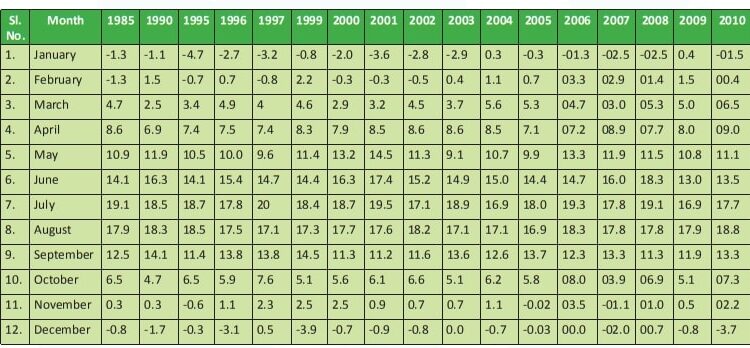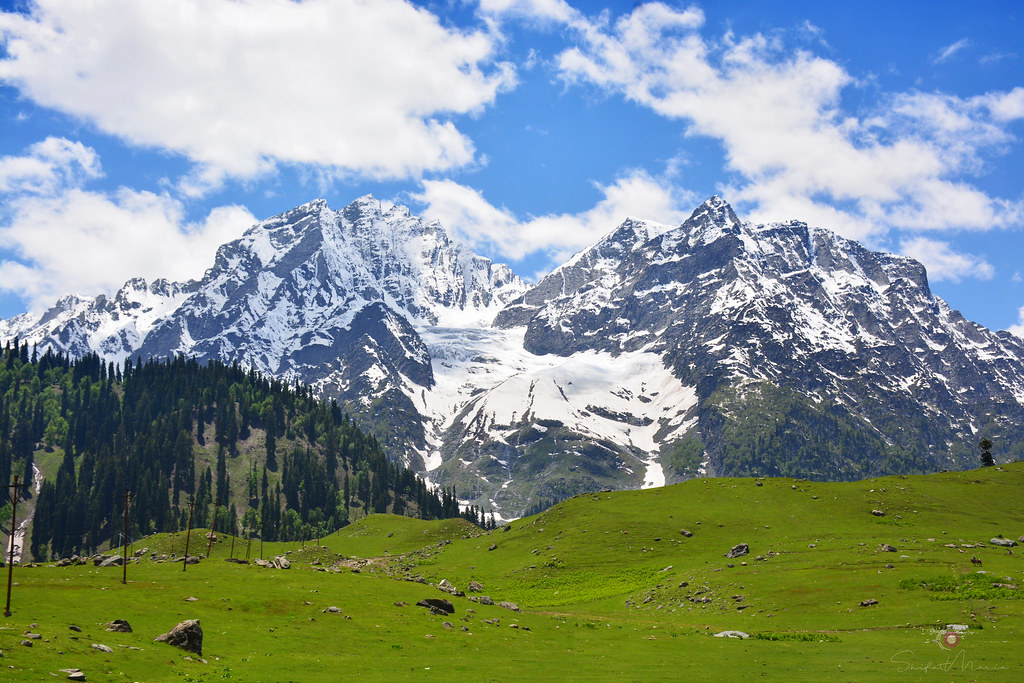Ever since the human evolutionary process got rolling, the climate has exerted influence on the evolutionary pattern and human lives and has also been affected by it in return. Alteration in climatic patterns corresponds to the negative effects on the entire ecosystem. Climate change is unambiguously a reality. It poses an unequivocal threat to the livelihood of people, biodiversity, water resources, agriculture, national growth, and political economies of nations on a global scale. It is characterized by the rise in global temperatures and the occurrence of extreme weather events such as heatwaves, droughts, and floods. Kashmir Himalayas, nestled in a huge Himalayan belt, is considered to be a hotspot for climate change risk owing to its complicated topography, massive glacial and water resources, quick-responding watersheds with severe seasonality, and climate variability on a smaller scale.
Climate change has accelerated the already rising temperature, and unstable precipitation patterns and worsened the vulnerabilities to drought, thereby bringing the Himalayan ecosystem to naught. As per the findings of the article, “Recent Glacier changes in Kashmir Alpine Himalayas, India” glaciers have shrunk by 17%. Another study ‘Linking the recent glacier retreat and depleting stream flow patterns with land system changes in Kashmir Himalaya (India)’ examined changes in the Kolahoi Glacier between 1962 and 2018, and reveals that the glacier is receding at an alarming rate. It has lost almost 23% of its land, splitting into smaller pieces since 1962. As per IPCC, the glacial meltdown is projected to swell flooding; avalanches from snow slopes will become rampant and erode water supplies down the river stream. Another study reveals that the annual precipitation is likely to plummet by a maximum of 2.09–6.61% in the 2080s. Along with, during the 2080s, the seasonal distribution of precipitation is predicted to change dramatically, with reductions of 9%, 5.7 %, and 1.7%, respectively, in the winter, spring, and summer seasons.
In light of the above-stated climatic transformations that have and will continue to cause life-altering events, it is important to understand, assess and evaluate the impact accounted by climate change in the Kashmir Himalayas. A study that maps climate hotspots over the forest cover in India using computer-model-based temperature and rainfall has been conducted for the three future time periods i.e. years 2030, 2050, and 2085. It has been observed that the biggest temperature rises are expected in Ladakh, Jammu-Kashmir, Himachal Pradesh, and Uttarakhand. Ladakh, Jammu & Kashmir, and Himachal Pradesh are expected to witness the smallest increases in rainfall if any at all. The temperature variation at Srinagar is shown in the table below:
Table: Temperature variation at Srinagar (degree celsius)

Source: State Action Plan on Climate Change (Jammu and Kashmir)
Additionally, according to the ENVIS newsletter (October-December, 2015) titled, “Climate Change and concerns of J&K”: Temperate deciduous, cool mixed, and conifer forests have grown significantly (11%) at the expense of alpine meadows, which are expected to shrink. Socio-economically, the repercussions are nothing less than a catastrophe as the Kashmir valley and Jammu wrestle to preserve its pristine flora comprising of Deodar, Fir, and spruce. Surprisingly, the Blue pine and Chir pine are left unscathed from the blight of climate change.
Not only the flora but fauna of Jammu & Kashmir seem to be in deep waters.
In recent times, the phenomenon of bird migration has witnessed peculiar trends, especially in the wetlands of Jammu, Kashmir, and Ladakh throughout the winter. The latest Asian Waterbird Census Report highlighted the richness and abundance of water birds, as well as the trend in the water bird population during five years of extensive surveys from 2015-to 2021, revealed that Kashmir has recorded a total of 6.4 lakh birds. Nonetheless, the number has decreased by 1.5 lakh since 2020. The region’s two Ramsar sites Hokersar wetland and Wular lake have seen a significant drop in the number of incoming birds. The census states that “birds in Hokersar wetland decreased from 4.8 lakh in 2020 to 65,000 in 2021, while birds in Wular decreased from 1.2 lakh to 707 birds in 2021”.
The scourge of climate change is evident with the intensification of forest fires. It is not surprising to know that forest fires due to rising heat waves are on surge in Kashmir Himalayas. Forest fires are frequent in the subtropical woods of the Jammu region, although their intensity and frequency have been low in the Kashmir region. However, as a result of global climate change, winter precipitation has been below average for the last few years, resulting in a dry fall, which produces an atmosphere conducive to forest fires. The region has thus witnessed an increased incidence of forest fires. According to the Forest Department’s official report, the year 2016 had unprecedented forest fire incidences. “In the state, there were about 781 forest fire occurrences registered.” The research noted that “these infernos affected an astounding 2556.3 hectares, which is more than 200 percent greater than the equivalent year 2015.” “Of the 781 events documented, 289 were fire incidents in Kashmir and 492 in the Jammu region,” according to the report. “In 2015, there were 214 fire events across the state, affecting 341.4 hectares of land. The state had 470 and 278 forest fire incidents in 2014 and 2013, respectively,” according to the report. The report notes that the number of forest fires in 2016 was higher than in prior years.
Figure 1: Incidents of forest fire in Jammu and Kashmir between 2013-2016.

We have understood how detrimental climate change can be for humans, culture, and ecology. However, to understand the consequences of climate change in Jammu and Kashmir, digging out the causes is a prerequisite. In J&K, unplanned urban growth, conflicts, changing socioeconomic profiles, excessive and unplanned exploitation of natural resources (like Dal Lake or deforestation), unplanned construction, climate variability and change, and many other factors all contribute to increased vulnerability to the Himalayan ecology. Key human interventions such as encroachment, pollution, siltation, and increasing resource exploitation, together with insufficient and improper planting, have a significant negative influence on the Himalayan environment. This regressive trend may be stopped with sustainable development practices that strive for balanced growth. Bearing in mind the harmful effects of climate change, the Government of Jammu and Kashmir introduced the Sustainable Himalaya Mission. The Sustainable Himalaya Mission aims to:
- A comprehensive investigation of the effects of climate change on species of plants, animals, and glacial ecology;
- research on the sensitivity of mountain ecosystems;
- Participation of the community in the preservation and protection of the mountain, terrestrial, and aquatic ecologies;
- Building capacities and increasing awareness among all stakeholders;
- Institutional growth for biodiversity protection and conservation;
- Climate grids’ identification and impact on forests and biological resources;
- ecological research on land and water;
- investigation of human involvement in ecological hotspots;
- study of how the climate affects the timing of migratory bird movements;
- Identification of the Himalayan ecosystem’s present state and a study of climate trends for the Himalayan environment.
Deleterious Ramifications:
Predictive risks experienced due to climate change will have major consequences for industries such as agriculture, water resources, and human health. Although the decrease in the number of frost days and an extension of the growing season may be beneficial to agriculture, however soaring temperatures and decreasing precipitation will result in increased water demands for irrigation. Teetering temperature and precipitation scenarios will exert a direct impact on water supplies and water-dependent systems. Dry spells are a new tendency in Kashmir’s environment, with exceptionally protracted dry periods occurring in recent years, causing severe water shortages. None of the 23 wells in Kashmir assessed for the May 2016 report had a water level moreover 20.0 meters below ground level, according to the Ground Water Year Book 2016-17. (m bgl). Water levels less than 2.0 m bgl have been recorded in 14 wells, according to the report, while the depth to the water level in seven wells ranges from 2 to 5 m bgl. One well showed water levels in the 5-10 m bgl range, and another well showed water levels in the 10-20 m bgl range.” During the summer and autumn seasons, prolonged dry periods, as indicated by consecutive dry days, have an impact on surface water availability.
Conclusion:
Climate change isn’t Hailey’s comet that will wake people from their carefree slumber after 75 years; rather it is akin to bacteria that grow speedily in space. Climate change is here to stay; therefore, it becomes imperative to prioritize and preserve biodiversity and address the climate change-based issues in Kashmir Himalayas. Climate change over mountainous basins demands a broader understanding of present and future temperature and precipitation regimes for better water resource management, hydropower generation, cryospheric resources, natural hazard risk assessment, and ecosystem response. The article calls for policy intervention in the future climate scenario of the Kashmir Himalayas. The changes in climatic conditions of the region will have serious ramifications in terms of water availability and the glacial environment of the Kashmir Himalayas.
References:
-
https://link.springer.com/article/10.1007/s00382-021-05984-6
-
-
http://jkenvis.org/pdf/newsletters/October_December_2015.pdf
-
-
https://www.researchgate.net/publication/331327910_Forest_Fire_-_JK_Scenario
-
-
https://www.sciencedirect.com/science/article/pii/S1470160X21001126
-
http://www.jkdears.com/eers/eers/orders/Final%20Report%20SAPCC.pdf



Leave a Reply
You must belogged in to post a comment.